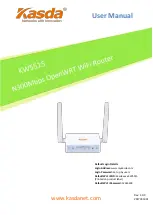
Modular Ethernet Switch User’s Guide
Unpacking and Setup
9
Figure 2–4. Installing a Module
Connecting a Terminal
The DES-6000 can perform basic switching functions without special configuration, but to use the Switch’s
advanced features you must first configure the unit through a terminal (a VT-100 serial data terminal or a
computer running a VT-100 emulator). The connection is made through the Switch’s Diagnostic RS-232 port,
which is configured at the factory as follows:
♦
Baud Rate:
9600
♦
Data Bits:
8
♦
Parity:
none
♦
Stop Bits:
1
♦
Flow Control: None
The RS-232 port has a nine-socket D-shell connector with IBM-type DCE wiring, and can be connected to the
terminal using an off-the-shelf RS-232 cable with the proper connectors for the terminal and the DES-6000.
Power on
Power up the DES-6000 as follows:
1.
Make sure the power module is properly installed in the device.
2.
Plug the device end of the supplied power cord firmly into the power inlet on the DES-6000’s front
panel of the redundant power supply.
3.
Plug the outlet end of the power cord firmly into a suitable AC outlet.
4.
Observe the DES-6000’s LED indicators to make sure the Switch is operating correctly.
The DES-6000’s LED indicators operate as follows during a normal power-up:















































